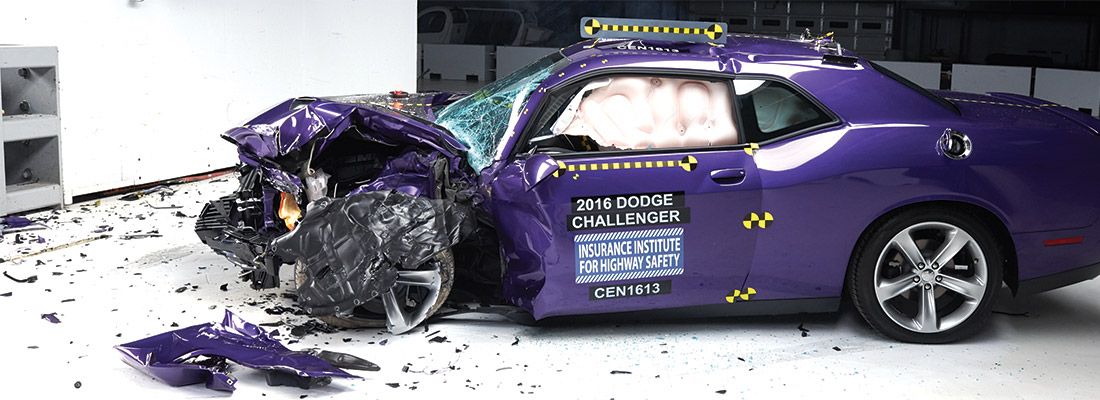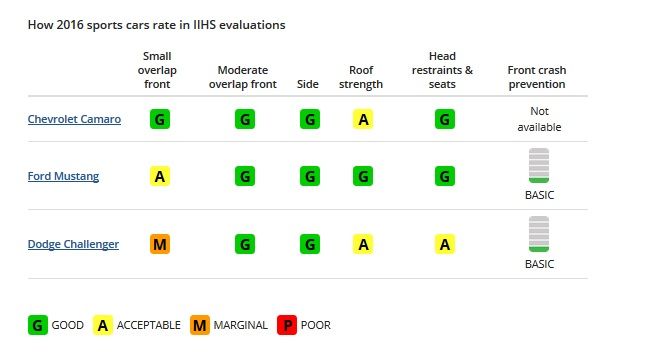The Insurance Institute for Highway Safety (IIHS) has just put America's most iconic muscle cars,->ke507 the Ford Mustang, Chevrolet Camaro, and Dodge Challenger, through its full battery of crash tests and announced that they all fell short of the Top Safety Pick status. To put that into perspective, all 65 2016-model-year vehicles tested up until now have achieved either the Top Safety Pick or Top Safety Pick+ ratings.
To qualify for Top Safety Pick, vehicles must earn good ratings in the small overlap front, moderate overlap front, side, roof strength and head restraint evaluations, and have a basic front crash prevention system. To earn Top Safety Pick+, cars must score good ratings in all five crash tests and earn an advanced or superior rating for front crash prevention.
According to the Institute, the Mustang->ke428 came closest to earning Top Safety Pick, while the Camaro->ke248 fell short in one category and lacks an available front crash prevention system. The Challenger->ke249 is most in need of improvement, which isn't surprising given that the current model is nine years old as of 2016. But despite failing to earn Top Safety Pick, all three cars scored good ratings for occupant protection in a moderate overlap front crash and side impact.
Although the IIHS doesn’t usually test sports cars, as they make up a small share of the market, the Institute decided to evaluate these models with optional V-8 engines because "they are big sellers in their class, and consumers often ask how they would perform in crash tests." As it turns out, not so good.
To sum it up, the Challenger suffered from extensive intrusion in the lower occupant compartment and the Mustang's roof buckled and compromised the driver's survival space. The Camaro, which was redesigned for the 2016 model year, fared better as its cage was strong enough and showcased a low risk of injuries to the dummy's legs, but the lack of an available front crash prevention system altered its final score.
Added in 2012, the small overlap test replicates what happens when a vehicle runs off the road and hits a tree or pole or crashes into another vehicle that has crossed the center line. In the test, 25 percent of the total width of the vehicle strikes the five-foot-tall rigid barrier on the driver side at 40 mph. The test involves a vehicle’s outer edges, which aren’t well-protected by the crush-zone structures and crash forces go directly into the front wheel, suspension system and, firewall.
Continue reading for the full story.
Why it matters
These results raise concern about the safety of motorists in cars that have high horsepower ratings and higher top speeds, which makes owners prone to more aggressive driving. According to data from the Highway Loss Data Institute, sports cars have the highest losses among passenger vehicles for crash damage repairs under collision coverage and it would make a lot of sense for them to have the best occupant crash protection on the market. Unfortunately, the test proves that's far from being the case. What's more, all three muscle cars are not even as safe as the average sedan. Sure, the Challenger and the Mustang are older than some 2016-model-year vehicles tested up until now, but this doesn't make the ratings less worrying.
It remains to be seen whether the Institute's crash test will change the way fast and powerful cars are being built as far as safety features go, but in the meantime it appears that the faster the vehicle, the more dangerous it is to its passengers in the event of a crash. Can you imagine a crash test involving the LaFerrari, McLaren P1, and Porsche 918 Spyder? Do you think these supercars will be able to pass any of the IIHS' five crash tests? Let us know in the comments section below.
Dodge Challenger
Read our full review on the Dodge Challenger here.
Chevrolet Camaro
Read our full review on the Chevrolet Camaro here.
Ford Mustang
Read our full review on the Ford Mustang here.





